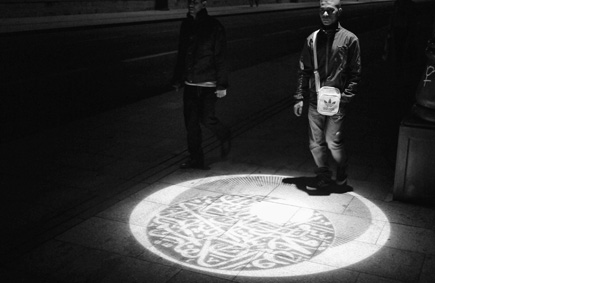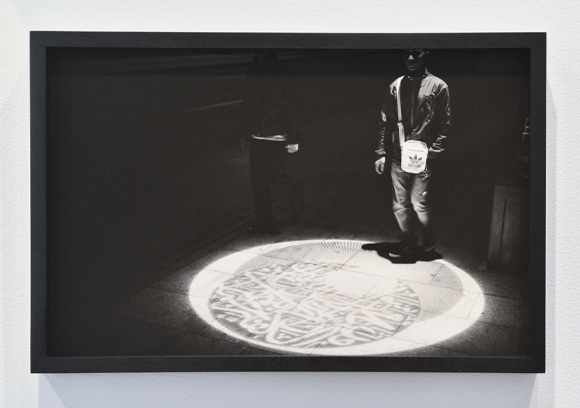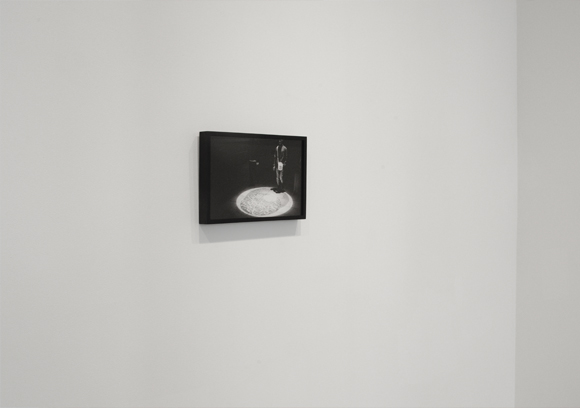| |
|
|
42.
| Walking on the Light |
| |


Started in 2012, print on baryte, 26 x 40 cm.
Exhibition view from Walking on the light, CCC Tours, 2014, Tours.
Courtesy of the artist and Jane Lombard Gallery, New York.
Ed. of 5 + 2 A.P.
'' For Fatmi the work was about light and beauty, modernism and abstraction, and of course, no one could walk on those lines from the Koran as they were fleeting light,
the shadow of the figure crossing onto the projection would in any case have blocked out the imagery under their feet. ''
Jane Lombard, September 2017

Walking on the Light
Exhibition view from Survival Signs, Jane Lombard Gallery, 2017, New York.
Courtesy of the artist.

Walking on the Light
Exhibition view from Survival Signs, Jane Lombard Gallery, 2017, New York.
Courtesy of the artist.
|
|
|
|
|
|
"Marcher sur la lumière" est une série de photographies réalisée à partir de l’installation lumineuse et cinétique "Technologia" (2012), dispositif projetant vingt cinq images circulaires sur un pont de Toulouse, parmi lesquelles les spectateurs peuvent déambuler librement et se laisser aller à la contemplation des lumières projetées au sol. L’oeuvre s'inspire des rotoreliefs de Duchamps, associés à la calligraphie arabe et aux paroles du prophète Mahomet.
Mettant en scène les spectateurs qui évoluent parmi les projections au sol, les photographies constituent les quelques rares images que l’artiste a eu le temps de faire, avant qu'une suite d'événements inattendus entraînent la suspension de son exposition publique et finalement sa censure. Au départ, il y a le geste d’une spectatrice marchant volontairement ou non sur une des projections lumineuses - geste aussitôt interprété comme un blasphème par d’autres spectateurs présents ce jour-là, et entraînant des manifestations religieuses dans la ville.
"Marcher sur la lumière" questionne le rapport problématique du public à l'œuvre et explore ce moment particulier qui précède un basculement entraînant l'incompréhension d'une partie du public et sa réaction de rejet, ainsi que le dévoiement des intentions de l'artiste. L'œuvre réalise une mise en scène de ce moment qui précède le basculement. Elle examine donc en quelque sorte les conditions d'une réaction chimique : elle en recense les éléments et les éventuels catalyseurs, et décrit leur configuration juste avant la réaction. La proposition fait allusion à la fois à l'événement ayant entraîné les manifestations puis la censure, et à la mention humoristique laissée par Mounir Fatmi sur un écriteau accompagnant l'installation : "Ne marchez pas sur l'œuvre". "Marcher sur la lumière" est une proposition polysémique qui peut être perçue de manière poétique, enfantine ou mystique. Elle renvoie à une impossibilité physique évidente. Elle fait écho à une forme d'expérience sensorielle et poétique qui s'exprimerait par métaphore. La lumière peut faire écho à la mystique religieuse où elle symboliserait Dieu lui-même. Elle peut également renvoyer aux connaissances et aux savoirs d'ordre profane. Rappelons enfin que les éclairages constituent un élément essentiel dans les domaines de la mise en scène et du spectacle...
La première photographie de la série montre deux personnages masculins immobiles, se tenant à la périphérie d'un cercle lumineux. L'un d'eux, situé sur la circonférence est éclairé par la lumière d'un projecteur, tandis que l'autre, un peu plus en retrait, demeure dans la pénombre. Cette photographie a ceci de particulier qu'elle fait apparaître très distinctement deux motifs graphiques aux influences internationales - versets religieux et logo de marque d'équipementier sportif. Par un effet du hasard, religion et société de consommation figurent dans la même mise en scène et le pouvoir de leur iconographie sur les individus et les consciences peut éventuellement être évoqué, analysé et comparé...
"Marcher sur la lumière" opère finalement un arrêt sur image aux effets de suspens et de dramatisation. L'instantané précède t-il une scène de révélation mystique ? Les spectateurs vont t'ils s'avancer encore sous la lumière, ou vont-ils rester sagement à la limite des cercles sans oser avancer plus loin. Le suspens évoqué est également d'un autre ordre : les photographies suspendent le jeu des significations et la chaîne des causes et conséquences. Elles reviennent sur un instant critique et pourraient être perçues comme une forme de provocation, mais elles réaffirment en réalité l'ouverture du sens propre aux œuvres d'art, qui autorise tous les jeux d'interprétation et tous les questionnements.
Studio Fatmi, Avril 2017.
|
|
“Walking on the Light” is a series of photographs created from the luminous and kinetic installation “Technologia” (2012), where 25 circular images were projected on a bridge in Toulouse. The spectators could walk freely between them and were encouraged to engage in the contemplation of the lights projected onto the ground. The work was inspired by Marcel Duchamp’s rotoreliefs and associated them with Arab calligraphy and the words of the prophet Muhammad.
The photographs show the spectators walking among the projections on the ground. They are the only ones the artist had the time to take before a series of unexpected events led to the suspension of the public exhibit and it was eventually censored. Everything started when a female spectator stepped, voluntarily or not, on one of the projections – a gesture that was immediately interpreted as blasphemy by other spectators present that day and led to religious protests in the city.
“Walking on the Light” questions the problematic relation of the audience with the work and explores this particular moment that preceded a tipping point leading to a failure to understand the work by a fraction of the public and its reaction of rejection, as well as the diversion of the artist’s intentions. In a way, it examines the conditions of a chemical reaction: it lists the elements and the potential catalyzers and describes their configuration just before the reaction happens. The proposition alludes to the event that triggered the protests and the censorship, as well as to the humorous comment left by mounir fatmi on a sign in the installation: “Please do not walk on the work”. “Walking on the Light” is a polysemous proposition which can be perceived in a poetic, childish or mystical way. It reflects an almost evident physical impossibility. It echoes a form of sensory and poetic experience that expresses itself in metaphors. The light can be evocative of religious mysticism, where it would be the symbol of God himself. It can also reference knowledge of a secular nature. And of course, lights are an essential element in the field of staging and show production…
The first photograph of the series shows two motionless male individuals near a luminous circle. One of them, standing on the edge, is illuminated by a projector, whereas the other, standing back, remains in the dark. This photograph is particular in the sense that it very distinctly shows two graphic motifs with international references – religious verses and the logo of a sportswear brand. Out of pure coincidence, religion and consumerism appear in the same scene and the power of their iconography over individuals and consciences can be evoked, analyzed and compared…
Finally, “Walking on the Light” offers a still image giving off an effect of suspense and dramatization. Does this image precede a scene of mystical revelation? Will the spectators walk further into the light or will they safely stay on the edge of the circles, not daring to go any further? The suspense is also of another kind: the photographs suspend the interactions between significations and the chain of cause and consequence. They bring up a critical moment and could be perceived as a form of provocation, but in reality they reaffirm the openness of the signification of works of art, which authorizes any interpretation and all forms of questioning.
Studio Fatmi, April 2017.
|
|
|
|